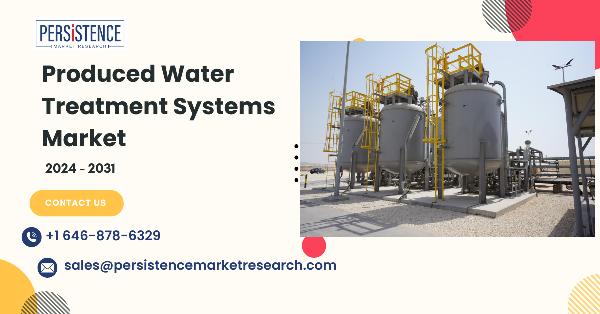How do these technologies compare in terms of efficiency and cost?

Strong 8k brings an ultra-HD IPTV experience to your living room and your pocket.
Produced water, a byproduct of oil and gas extraction, demands efficient and cost-effective treatment technologies to ensure safe disposal or reuse. The wide range of treatment technologies available each offers different levels of efficiency and cost implications. This detailed analysis compares the most common treatment technologies for produced water, focusing on their efficiency, cost-effectiveness, and overall suitability for various applications.
For More Industry Insight: https://www.persistencemarketresearch.com/market-research/produced-water-treatment-systems-market.asp
1. Mechanical Separation Technologies
Mechanical separation technologies are foundational methods in produced water treatment, utilizing physical processes to separate contaminants. Here's a comparison of their efficiency and cost:
a. Settling Tanks
Efficiency: Settling tanks, or gravity separators, are effective for removing large particles and oil droplets from produced water. They work by allowing water to flow slowly through a tank, enabling heavier contaminants to settle at the bottom. This method is relatively simple and effective for initial separation but may not fully remove smaller particles or emulsified oil.
Cost: The capital and operational costs for settling tanks are relatively low compared to other technologies. They require minimal maintenance and are inexpensive to construct. However, their effectiveness may be limited, necessitating additional treatment stages for thorough processing.
b. Centrifuges
Efficiency: Centrifuges are highly efficient in separating oil, water, and fine solids based on their density. The rapid spinning creates centrifugal forces that effectively separate different phases, making centrifuges suitable for applications requiring precise separation. They are particularly effective in handling high volumes of produced water and can achieve high levels of purity.
Cost: The initial capital investment for centrifuges is higher compared to settling tanks. Additionally, they have higher operational and maintenance costs due to the complexity of their mechanical components. Despite these costs, their efficiency in separating contaminants can reduce the need for additional treatment stages, potentially offsetting the higher initial investment.
c. Hydrocyclones
Efficiency: Hydrocyclones are effective at removing suspended solids and free oil from produced water through centrifugal force. They are particularly good at handling large volumes of water and can achieve a high degree of separation for particulates and oil. However, they may not be as effective in removing dissolved contaminants or emulsified oils.
Cost: Hydrocyclones are generally more cost-effective than centrifuges, with lower capital and operational costs. They are relatively simple in design and require less maintenance. However, their efficiency is highly dependent on the design and operational parameters, and they may need to be combined with other treatment methods for comprehensive water treatment.
2. Chemical Treatment Technologies
Chemical treatment technologies involve the addition of chemicals to facilitate the removal of contaminants. Here's a comparison of their efficiency and cost:
a. Flocculation and Coagulation
Efficiency: Flocculation and coagulation are highly effective for removing suspended solids, colloidal particles, and emulsified oil from produced water. By adding coagulants and flocculants, contaminants aggregate into larger flocs that can be easily removed through sedimentation or filtration. These processes can significantly improve water quality and are often used in conjunction with other treatment technologies.
Cost: The cost of flocculation and coagulation includes the price of chemicals, as well as operational and maintenance costs. While the chemical costs can be significant, the overall operational costs are moderate. This method is relatively cost-effective for treating large volumes of produced water when compared to more complex treatment systems. However, it requires careful management of chemical dosing and monitoring to ensure optimal performance.
b. Chemical Oxidation
Efficiency: Chemical oxidation processes, such as advanced oxidation processes (AOPs), use strong oxidizing agents to break down organic contaminants in produced water. These methods are highly effective in treating complex mixtures of pollutants and can achieve high levels of degradation. They are particularly useful for removing recalcitrant organic compounds that are difficult to treat with other methods.
Cost: The capital and operational costs for chemical oxidation are relatively high due to the need for specialized equipment and chemicals. AOPs, for instance, require advanced reactors and high-energy inputs, which can make them costly to operate. Despite their high efficiency, the expense associated with these technologies may limit their application to scenarios where other treatment methods are insufficient.
3. Membrane Technologies
Membrane technologies use semi-permeable membranes to separate contaminants from produced water. Common membrane technologies include:
a. Reverse Osmosis (RO)
Efficiency: Reverse osmosis is highly effective in removing a wide range of contaminants, including salts, organic compounds, and suspended solids. RO membranes can achieve high levels of water purity and are suitable for applications requiring high-quality treated water. However, RO may have limitations in handling high fouling potentials and high salinity.
Cost: The initial capital investment for RO systems is high due to the cost of membranes and high-pressure pumps. Operational costs are also significant, involving energy consumption for pressurizing the water and regular maintenance of membranes. Despite these costs, RO's high efficiency in producing clean water can justify the investment in applications where water quality is paramount.
b. Ultrafiltration (UF) and Microfiltration (MF)
Efficiency: Ultrafiltration and microfiltration are effective for removing suspended solids, colloidal particles, and some microorganisms from produced water. These technologies are less effective in removing dissolved contaminants or smaller organic molecules compared to RO. UF and MF are often used as pre-treatment stages before more advanced processes.
Cost: UF and MF systems generally have lower capital and operational costs compared to RO. They require less energy and have lower maintenance requirements. However, their effectiveness is limited to certain types of contaminants, and they may need to be combined with other treatment technologies to achieve desired water quality levels.
4. Biological Treatment Technologies
Biological treatment technologies use microorganisms to degrade organic contaminants in produced water. Common biological treatment methods include:
a. Activated Sludge Processes
Efficiency: Activated sludge processes are effective for treating organic contaminants through microbial degradation. This method can achieve significant reductions in biochemical oxygen demand (BOD) and total suspended solids (TSS). Activated sludge systems are suitable for treating large volumes of produced water with high organic loads.
Cost: The capital and operational costs for activated sludge processes are moderate. Costs include the construction of aeration tanks and the ongoing expense of maintaining microbial cultures. While these systems are cost-effective for treating organic pollutants, they may require additional treatment stages to address other contaminants.
b. Biofilters and Biotrickling Filters
Efficiency: Biofilters and biotrickling filters use microbial growth on filter media to treat produced water. These systems are effective for removing volatile organic compounds (VOCs) and other organic contaminants. They offer a biological treatment option with relatively low energy requirements and can be used in conjunction with other treatment methods.
Cost: Biofilters and biotrickling filters have moderate capital and operational costs. They require investment in filter media and maintenance of microbial cultures. Their cost-effectiveness is influenced by the specific contaminants being treated and the overall system design.
Note: IndiBlogHub features both user-submitted and editorial content. We do not verify third-party contributions. Read our Disclaimer and Privacy Policyfor details.


